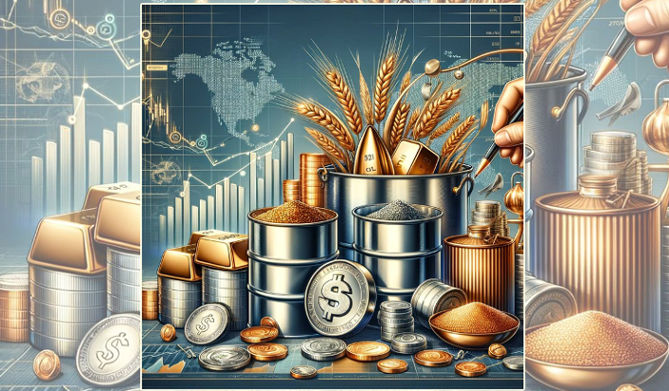
What Are Commodities?
Before diving into diversification strategies, it’s essential to understand what commodities are. Commodities are basic goods used in commerce that are interchangeable with other goods of the same type. They are divided into two broad categories:
- Hard Commodities: These include natural resources that are mined or extracted, such as gold, oil, and copper.
- Soft Commodities: These include agricultural products or livestock, such as wheat, coffee, sugar, and cattle.
The value of commodities is influenced by supply and demand dynamics, geopolitical events, and economic trends. Because of their inherent value, commodities are often seen as a safe haven during economic downturns.
What Is the Commodities Market?
To understand how to invest in commodities, you need to know what the commodities market is. The commodities market is a marketplace where raw or primary products are exchanged. These markets are vital because they provide a centralized platform for buyers and sellers to trade commodities efficiently. The two main types of markets for trading commodities are:
- Spot Markets: Also known as “cash markets,” where commodities are traded for immediate delivery.
- Futures Markets: These involve contracts to buy or sell commodities at a predetermined price on a future date.
Investors often use the futures market to hedge against price fluctuations or to speculate on price movements. Understanding what the commodities market is will help you make informed decisions about which commodities to include in your portfolio.
Why Diversify with Commodities?
Diversifying with commodities can protect your portfolio against inflation, currency devaluation, and other market risks. Here’s why adding commodities can be beneficial:
- Inflation Hedge: Commodities often maintain or increase in value when inflation rises, making them a good hedge against the eroding purchasing power of money.
- Low Correlation with Stocks and Bonds: Commodities typically have a low correlation with traditional assets like stocks and bonds, which means they often move in the opposite direction of these markets, providing balance to your portfolio.
- Tangible Assets: Unlike stocks and bonds, commodities are physical assets that can hold intrinsic value over time, making them less susceptible to market manipulation or corporate fraud.

How to Invest in Commodities
Now that you understand the benefits, let’s discuss the different ways to invest in commodities. There are several approaches, each with its own level of risk and complexity:
1. Direct Investment
One of the most straightforward ways to invest in commodities is to purchase the physical goods themselves. For example, you can buy gold bullion or silver coins. While this approach provides direct exposure to the commodity, it also requires secure storage and insurance, which can be costly.
2. Commodity ETFs
Exchange-Traded Funds (ETFs) are a popular way to invest in commodities without the need to physically hold the assets. Commodity ETFs track the price of specific commodities or a basket of commodities. They offer liquidity and the ability to trade like a stock. For instance, the SPDR Gold Shares (GLD) ETF tracks the price of gold.
3. Commodity Mutual Funds
Similar to ETFs, commodity mutual funds pool investor money to invest in a diversified portfolio of commodities. These funds are managed by professional fund managers who make investment decisions on behalf of investors. Mutual funds often have higher fees than ETFs but provide professional management and diversification.
4. Futures Contracts
Futures contracts are agreements to buy or sell a specific quantity of a commodity at a predetermined price on a specific date in the future. Futures are a more complex and risky investment, suitable for experienced investors who understand the commodities market. However, they offer the potential for significant profits due to leverage.
5. Stocks of Commodity-Related Companies
Another indirect way to gain exposure to commodities is by investing in the stocks of companies involved in the production or distribution of commodities. For example, investing in oil companies like ExxonMobil or mining companies like Barrick Gold can provide exposure to the commodities market. This approach combines the benefits of equity investments with commodity exposure.
Understanding What Is Commodities Market
Understanding what the commodities market is and how it functions is crucial for successful investing. The commodities market operates on a global scale, with key exchanges like the New York Mercantile Exchange (NYMEX), the Chicago Mercantile Exchange (CME), and the London Metal Exchange (LME) playing significant roles. These exchanges standardize contracts, provide liquidity, and ensure transparency in pricing.
Market Participants
The commodities market is made up of various participants, each with different motivations:
- Producers: Companies or individuals that produce commodities, such as farmers or mining companies. They use the commodities market to lock in prices for future sales, protecting against price volatility.
- Speculators: Traders who aim to profit from price fluctuations in the commodities market. Speculators take on risk by betting on future price movements without the intention of taking physical delivery of the commodity.
- Hedgers: These are typically producers or consumers of commodities who use the futures market to hedge against adverse price movements. For example, an airline might buy oil futures to lock in fuel prices and protect against price spikes.

Strategies for Diversifying with Commodities
Diversifying your portfolio with commodities requires a well-thought-out strategy. Here are some approaches to consider:
1. Balanced Portfolio Approach
A balanced approach involves allocating a portion of your portfolio to commodities while maintaining investments in stocks, bonds, and other assets. For example, you might allocate 10-20% of your portfolio to commodities, depending on your risk tolerance and investment goals.
2. Thematic Investing
Thematic investing involves focusing on commodities that align with specific trends or themes. For instance, as the world shifts towards renewable energy, investing in metals like lithium and copper, which are essential for battery production, could be a strategic move.
3. Global Diversification
Commodities are global assets, and their prices can be influenced by events in different parts of the world. To mitigate regional risks, consider diversifying across commodities from different regions. For example, investing in both North American oil and Middle Eastern oil can spread your risk.
4. Regular Rebalancing
As with any investment, regularly rebalancing your commodity holdings is crucial to maintaining your desired asset allocation. Commodity prices can fluctuate significantly, so it’s important to review and adjust your portfolio periodically to ensure it remains aligned with your investment goals.
How to Get Started
If you’re new to commodities, it’s advisable to start small and gradually increase your exposure as you become more comfortable with the market. Here are some steps to get started:
- Educate Yourself: Begin by learning more about what the commodities market is and the different ways to invest. Books, online courses, and financial news websites can be valuable resources.
- Set Investment Goals: Determine your investment objectives and how commodities fit into your overall portfolio strategy. Are you looking to hedge against inflation, or are you seeking to capitalize on global economic trends?
- Choose the Right Instruments: Based on your goals and risk tolerance, choose the investment vehicles that best suit your needs. For beginners, commodity ETFs or mutual funds may be a safer starting point than futures contracts.
- Monitor the Market: Keep an eye on global economic indicators, supply and demand trends, and geopolitical events that could affect commodity prices. Staying informed will help you make timely investment decisions.
- Consult a Financial Advisor: If you’re unsure about how to diversify your portfolio with commodities, consider consulting a financial advisor. They can provide personalized advice based on your financial situation and investment goals.